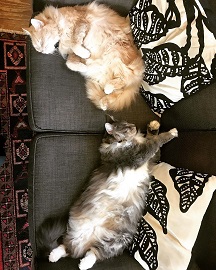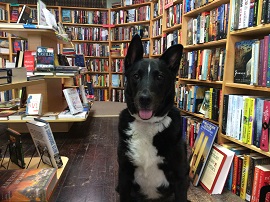- Categories:
Marketing Meetup Recap: Marketing Your Bookstore Pet
- By Emily Behnke
On Thursday, January 30, the American Booksellers Association presented the Marketing Meetup “Marketing Your Bookstore Pet,” which focused on how booksellers can leverage their furry and cuddly (or even not-so-furry or cuddly) pets to drive attention to their store and bring in customers.
Guest speakers included Rebecca Binkowski of MacIntosh Books and Paper in Sanibel, Florida;Jessica Osborne of E. Shaver, Bookseller in Savannah, Georgia; Christine Burke of Clues Unlimited in Tucson, Arizona; Anna Hersh and Drew Sieplinga of Wild Rumpus in Minneapolis. Additional information was provided by Carrie Deming of The Dog Eared Book in Palmyra, New York.
Here are some of the key points from the session:

-
Binkowski got her bookstore cat, Brady, through her local no-kill shelter.
- She didn’t look at Brady as a marketing opportunity at first — she knew her staff would love Brady, but she wasn’t sure about her customers. Now, she uses Brady across the store’s social media accounts, and he’s garnered a great response. They also use the hashtag #SanibelShopCat.
- Brady lives in the store, so he has a dedicated space to step away from customers if he wants. There’s a cat door that leads to a back office where he can nap.
- MacIntosh always has two staff members on at a time, so someone can look out for Brady and be sure he isn’t overstimulated or trying to get outside.
-
Burke started with a bookstore guinea pig and worked up to a potbellied pig. When the pig could no longer come to the store, she began bringing in her greyhound. Pets give the store a warm atmosphere, she said, and they also offer a great opportunity for marketing.
- Burke includes “Pet Picks” in the store’s newsletter, which are typically animal-related or children’s titles.
- She’s also worked with greyhound rescues and her local humane society for events, which has helped get her store’s name out there.
- Burke recommended that booksellers make sure to get a pet that enjoys being in the store.
-
Osborne has multiple pets at E. Shaver. She adopted two kittens from her local rescue, at first to just give them a home, but they turned out to be popular with customers. There’s a sign on the front of the store that alerts customers that there are cats inside, and there are also signs in-store that ask customers to not pick up the cats.
-

Riley of Dog Eared Book in Palmyra, New York.Osborne features the cats on the store’s social media; she made sure that her reps knew about the cats when she got them, so she could be alerted about cat-related titles. She also has bookmarks that feature the cats, and they will soon be featured on bags. The cats are now being incorporated into the store’s logo as well.
- Her cats live in the shop, which can present difficulties that booksellers should keep in mind, including emergency preparedness and scheduling vet appointments.
- If the store is crowded, staff members will bring the cats to the back room to mitigate their stress. The litter box is also kept in the back room to reduce odors.
- Booksellers should plan for their pet’s retirement. When a pet gets older and doesn’t want to be in the store anymore, booksellers should have a plan for what to do next.
-
-
Deming has a 70-pound mixed-breed dog, Riley, from the local humane society. He’s a good conversation starter with customers and helps staff members start a rapport to better hand-sell books.
- If there are titles the store wants to promote, staff snaps pictures of the book with Riley. They also use him to promote events with the humane society.
- They’re planning to host a “Reading With Riley” event for reluctant readers, as he’s extremely popular with children.
- Booksellers considering having a bookstore pet should be sure their pet has a great personality because children who play with them can be unpredictable.
- Booksellers should be sure that pets have a place where they can take a break from customers.

